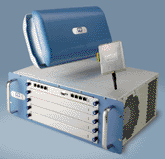Wireless Technology: RadioFrame System Can Go With The Flow
RadioFrame, which counts Craig McCaw's COM Investments and Nextel Communications among its investors, created a system that uses a modular design to provide support for a variety of wireless technologies. The idea was to offer customers an infrastructure that could be changed easily as wireless technology advances, said RadioFrame President Jeff Brown.

\
The RadioFrame product, which is based on a modular design, provides support for a variety of wireless technologies.
"Our network fabric can supply connectivity to a variety of different wireless technologies," he said. "We really allow the enterprise or carriers to effectively manage a continuously changing market."
Launched in October 2001, the RadioFrame infrastructure consists of shoe-box-size access points that can hold up to seven different removable radio cards. Up to seven of those access points connect via Category 5 Ethernet to two separate chassis that interface with corporate PBX systems, connect to the Internet and route traffic. The scalable system supports 32,000 square feet to 2 million square feet.
RadioFrame currently manufactures radio cards for 802.11a, Wi-Fi, GSM/GPRS and integrated Dispatch Enhanced Network, and will support other technologies as they become more popular in the United States, Brown said.
Carriers can use the system to provide a strong cellular signal on a campus and at conventions or airports, and to offer wireless LAN capabilities in the same area, said Brown. At the same time, large companies that want to extend cellular phone use in an office environment or to "future-proof" wireless networking can take advantage of the system, he said.
RadioFrame has been selling the product direct to carriers but is ready to extend it to integrators. By the end of the quarter, the company expects to be able to name a couple of key systems integrator partners that serve the carrier market.
"We'll start to work with a few systems integrators that make a practice of selling and deploying solutions for network operators around the world," said Mark Anderson, vice president of business development at RadioFrame.
By the fourth quarter, the company would like to start moving its product through solution providers working in the enterprise space, said Anderson.
But he acknowledges that there are challenges in reaching some integrators and VARs.
To make full use of the RadioFrame system's capabilities, carriers must approve use of its signal within an enterprise office space. And solution providers are quick to point out the difficulties of working with the carrier community.
Gary Berzack, CEO of Tribeca Technologies, a wireless specialist in New York, is interested in the product but said he's unaware of any carriers that would allow a VAR to use their cellular radio to install a RadioFrame system.
"It would be great if I could be certified through RadioFrame to offer this on behalf of AT&T [Wireless or Verizon [Wireless," Berzack said. "RadioFrame needs to identify a set of integrators who can be certified as enablers of this technology for cellular carriers."
Anderson said it's likely that carriers will resell the products themselves. "They want to own the equipment so they can ultimately ask customers to sign up for longer-term contracts," he said.
The RadioFrame system is priced at about 10 cents to 20 cents per square foot, based on a 1-million-square-foot installation, said Brown.
At $100,000 to $200,000 per installation, the system might be pricey for the enterprise but more palatable for carriers that want to install it on campuses, at convention centers or in airports, said Berzack.